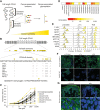Targeting Solid Cancers with a Cancer-Specific Monoclonal Antibody to Surface Expressed Aberrantly O-glycosylated Proteins
- PMID: 37451822
- PMCID: PMC10543972
- DOI: 10.1158/1535-7163.MCT-23-0221
Targeting Solid Cancers with a Cancer-Specific Monoclonal Antibody to Surface Expressed Aberrantly O-glycosylated Proteins
Abstract
The lack of antibodies with sufficient cancer selectivity is currently limiting the treatment of solid tumors by immunotherapies. Most current immunotherapeutic targets are tumor-associated antigens that are also found in healthy tissues and often do not display sufficient cancer selectivity to be used as targets for potent antibody-based immunotherapeutic treatments, such as chimeric antigen receptor (CAR) T cells. Many solid tumors, however, display aberrant glycosylation that results in expression of tumor-associated carbohydrate antigens that are distinct from healthy tissues. Targeting aberrantly glycosylated glycopeptide epitopes within existing or novel glycoprotein targets may provide the cancer selectivity needed for immunotherapy of solid tumors. However, to date only a few such glycopeptide epitopes have been targeted. Here, we used O-glycoproteomics data from multiple cell lines to identify a glycopeptide epitope in CD44v6, a cancer-associated CD44 isoform, and developed a cancer-specific mAb, 4C8, through a glycopeptide immunization strategy. 4C8 selectively binds to Tn-glycosylated CD44v6 in a site-specific manner with low nanomolar affinity. 4C8 was shown to be highly cancer specific by IHC of sections from multiple healthy and cancerous tissues. 4C8 CAR T cells demonstrated target-specific cytotoxicity in vitro and significant tumor regression and increased survival in vivo. Importantly, 4C8 CAR T cells were able to selectively kill target cells in a mixed organotypic skin cancer model having abundant CD44v6 expression without affecting healthy keratinocytes, indicating tolerability and safety.
©2023 The Authors; Published by the American Association for Cancer Research.
Figures





References
Publication types
MeSH terms
Substances
LinkOut - more resources
Full Text Sources
Medical
Miscellaneous

